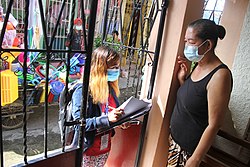The Philippine census is a regularly occurring and official inventory of the human population and housing units in the Philippines. Since 1970, the population has been enumerated every five years.[a] Results from the censuses are used to allocate congressional seats and fund government programs.
| Philippine census | |
|---|---|
 A census enumerator interviewing a resident of Dasmariñas in October 2020 | |
| Frequency | Every five years |
| Country | Philippines |
| Inaugurated | 1877 |
| Most recent | 2024; 0 years ago |
| Previous event | 2020; 4 years ago |
| Next event | 2030 |
| Organized by | Philippine Statistics Authority (since 2015) |
The mid-year census is known as the Census of Population (POPCEN), while the decennial census is referred to as the Census of Population and Housing (CPH).
By virtue of Republic Act No. 10625, known as the Philippine Statistical Act of 2013, censuses in the Philippines have been administered by the Philippine Statistics Authority (PSA) since the 2015 census.[1]
History
The first census in the Philippines in 1591, was based on tributes collected and yielded about 666,712 people in the islands. In 1799, Friar Manuel Buzeta estimated the population count as 1,502,574. However, the first official census in the Philippines was carried out by the Spanish government pursuant to a royal decree calling for the counting of persons living as of the midnight of December 31, 1877. Based on this census, the Philippines had a population of 5,567,685 as of the reference date.[2] This was followed by another censuses, the 1887 census that yielded a count of 5,984,727.[3]
The first census conducted by the U.S. military forces took place in 1903 to fulfill Public Act 467 which was approved by the United States Philippine Commission on October 6, 1902.[4]
A four-volume description of this census was on hand some years ago at the National Archives in San Bruno, California, but the volumes appear to have since been misplaced.[citation needed]
Statistics
For years between the censuses, the PSA and its precursor agencies have been issuing estimates made using surveys and statistical systems.
Based on the 2020 Philippine census, the national population is 109,035,343 as of May 1, 2020. From 2015 to 2020, the population grew by 1.63% per year on the average.[5][6][7][8][9]
| Year[b] | Population[10][11] | Change | Most populated region | Most populated city | Notes | Organized by |
|---|---|---|---|---|---|---|
| 1799 | 1,502,574[c] | — | — | — | According to Fr. Buzeta | — |
| 1800 | 1,561,251[c] | — | — | According to Fr. Zuniga | — | |
| 1812 | 1,933,331[c] | — | — | According to cedulas | — | |
| 1819 | 2,106,230[c] | — | — | According to cedulas | — | |
| 1829 | 2,593,287[c] | — | — | According to the Church | — | |
| 1840 | 3,096,031[c] | — | — | According to local officials | — | |
| 1850 | 3,857,424[c] | — | — | According to Fr. Buzeta | — | |
| 1858 | 4,290,381[c] | — | — | According to Bowring | — | |
| 1870 | 4,712,006[c] | — | — | According to Guia de Manila | — | |
| 1877 | 5,567,685[c] | — | — | First official census by the Spanish government | Spanish colonial government | |
| 1887 | 5,984,727[c] | — | — | |||
| 1896 | 6,261,339[c] | — | — | According to Plehn | — | |
| 1903 | 7,635,426 | — | Manila (219,928) |
First official census by the US government | United States government | |
| 1918 | 10,314,310 | — | Manila (285,306) |
|||
| 1939 | 16,000,303 | — | Manila (623,492) |
Only census of the Commonwealth of the Philippines | ||
| 1948 | 19,234,182 | — | Manila (983,906) |
First census of the independent Republic of the Philippines | Bureau of the Census and Statistics | |
| 1960 | 27,087,685 | — | Manila (1,138,611) |
|||
| 1970 | 36,684,486 | — | Manila (1,330,788) |
|||
| 1975 | 42,070,660 | — | Manila (1,479,116) |
National Census and Statistics Office | ||
| 1980 | 48,098,460 | Metro Manila (5,925,884) |
Manila (1,630,485) |
|||
| 1985 | No census was held due to a political and economic crisis | |||||
| 1990 | 60,703,206 | Metro Manila (7,948,392) |
Quezon City (1,669,776) |
|||
| 1995 | 68,616,536 | Metro Manila (9,454,040) |
Quezon City (1,989,419) |
National Statistics Office | ||
| 2000 | 76,506,928 | Metro Manila (9,932,560) |
Quezon City (2,173,831) |
|||
| 2007 | 88,566,732 | Metro Manila (11,553,427) |
Quezon City (2,679,450) |
The census was not taken in 2005 due to a reenacted budget that lasted until 2006 | ||
| 2010 | 92,337,852 | Calabarzon (12,609,803) |
Quezon City (2,761,720) |
|||
| 2015 | 100,981,437 | Calabarzon (14,414,774) |
Quezon City (2,936,116) |
First census to record a population exceeding 100 million | Philippine Statistics Authority | |
| 2020 | 109,035,343 | Calabarzon (16,195,042) |
Quezon City (2,960,048) |
|||
| 2024 | To be held | |||||
Notes
References
External links
Wikiwand in your browser!
Seamless Wikipedia browsing. On steroids.
Every time you click a link to Wikipedia, Wiktionary or Wikiquote in your browser's search results, it will show the modern Wikiwand interface.
Wikiwand extension is a five stars, simple, with minimum permission required to keep your browsing private, safe and transparent.
